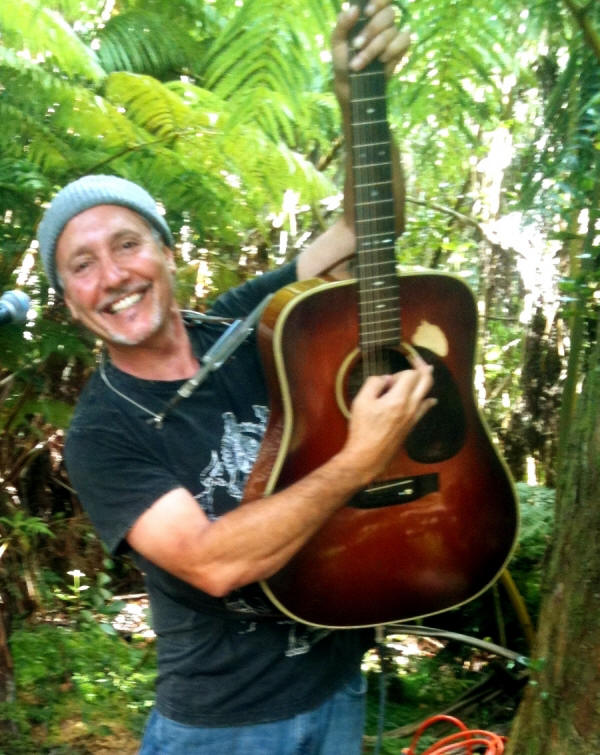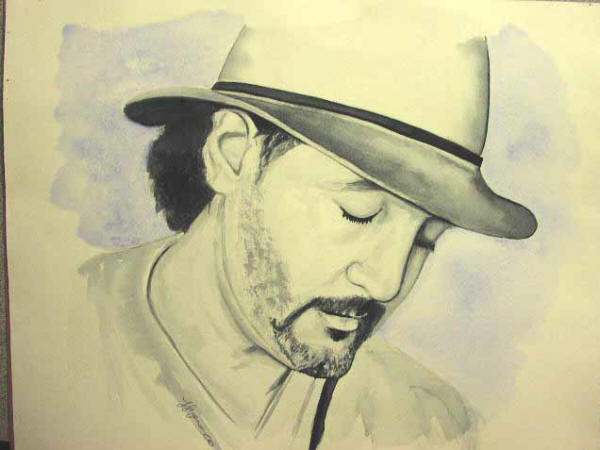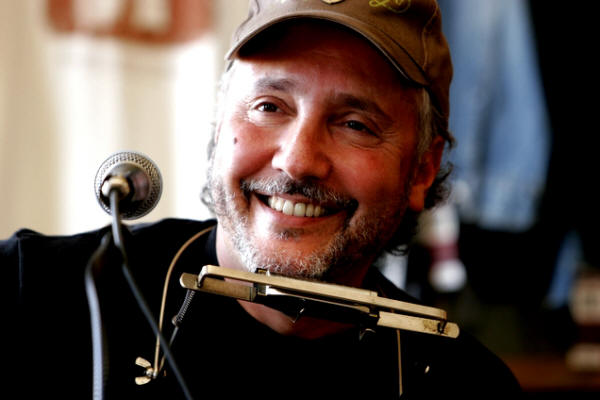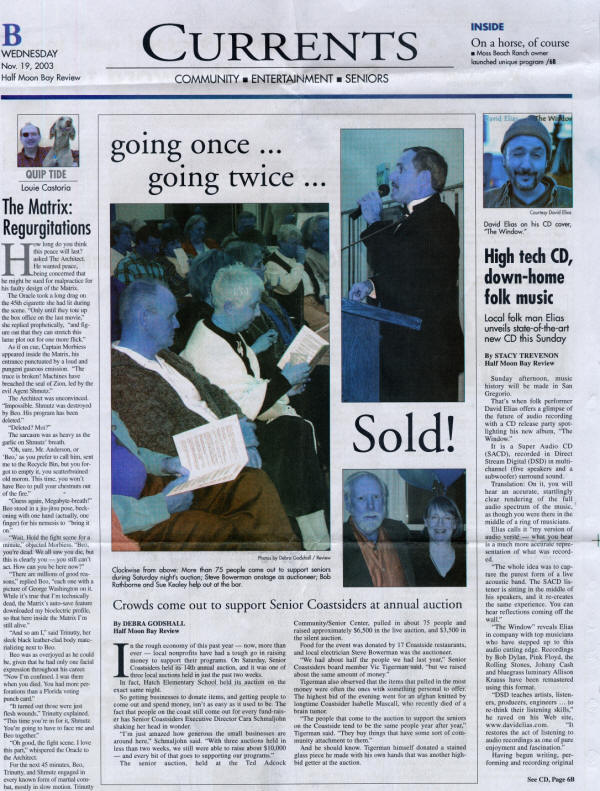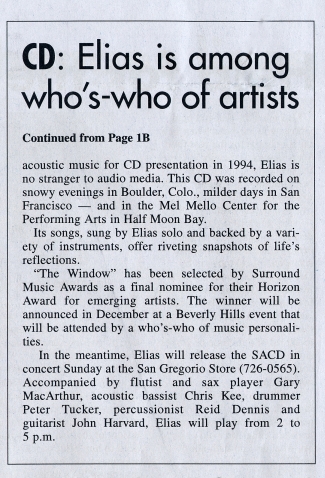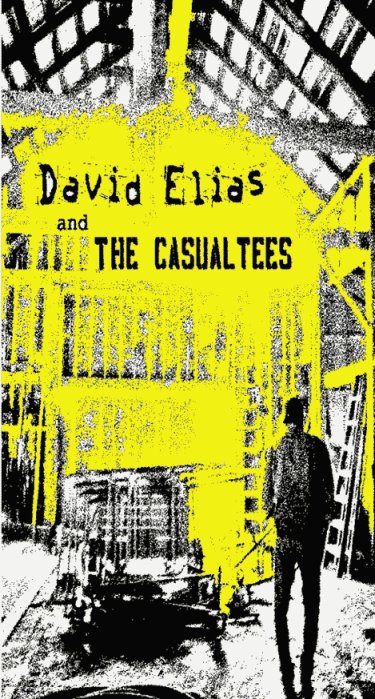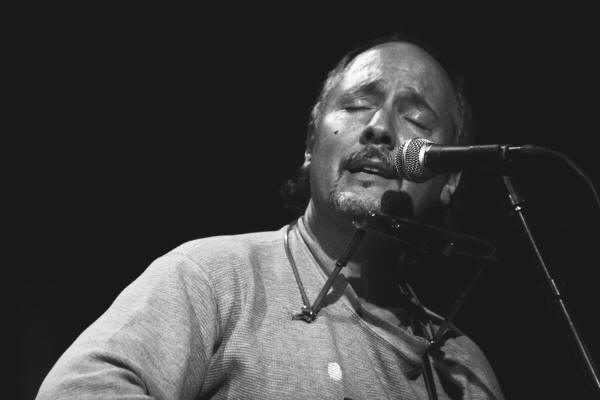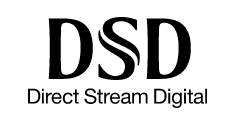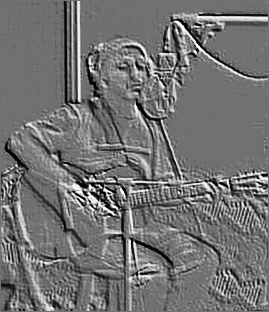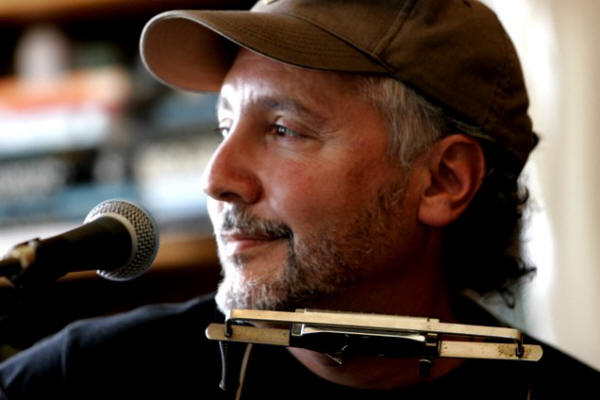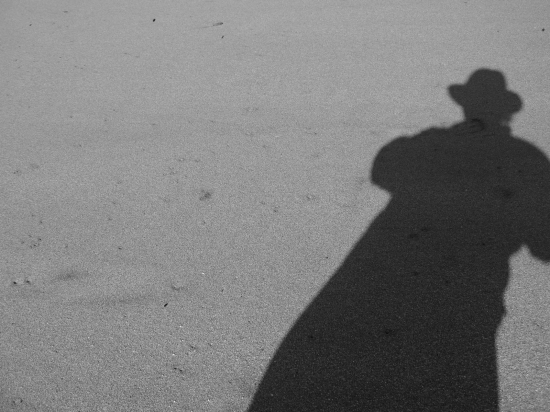You are reading the older HTML site
Positive Feedback ISSUE 69
My Blogosphere Thoughts on DSD
David Elias Drawing by
Lucy Lyons [David Elias is a gifted songwriter and guitarist now living on the Big Island of Hawai'i. His SACDs The Window and Crossing are brilliant examples of what pure DSD can do to provide us with recordings that really capture the feel of live music and studio sessions. He worked with Gus Skinas of the Super Audio Center in the earlier days of SACD, and now continues his work with DSD on the Big Island. David and I have been acquainted for years. He has started a blog about music, art, life, and DSD over at http://davideliasblog.wordpress.com. It's recommended stuff! Here's a recent blog about DSD that David has kindly consented to allow re-publication here at PFO. Mahalo, hoaloha! Given the very recent developments on the DSD front, this is a great time to share David's reflections with you. All images are courtesy of David Elias. David W. Robinson, E-in-C]
The biggest incentive I had to start this blog was to offer my experience and maybe some technical clarifications or explanations to those interested in hi-res recordings, and DSD downloads + SACD discs in particular. No doubt there are a lot of confusing technologies and messages out there. But I am focused on the desire to hear high-quality acoustic recordings. The source of the recordings might be a live performance in a studio or on a stage or from an earlier recording (master), either analog (say 1/2 or 1/4 inch tape recordings or masters) or digital. I have had a fairly unique vantage point on a lot of this, especially during the early 10-year SACD growth period between 2000 and 2010. I wasn't part of the music recording industry, though I was a working and recording musician in the SF Bay Area. So I was able to see the creation of an industry segment that I was independent of.
I had no manager, no booking agent, no record contract, PR agent or any of the rest of it. I wasn't really looking for any of that either. What I wanted to do was to make good recordings of my songs. I also wanted to perform in places that sounded good to me. I had already climbed the DIY music ladder from its infancy in those first web+browser days in 1994 and 1995 when my first self-made CD called Lost in the Green (http://cdbaby/cd/elias2) came out. The web at that time offered me a direct communication path to public and college radio stations all over the U.S., as well as to other countries. This was new! I don't recall any of the stations broadcasting their shows on the web at that point, just posting info, including contact email. Most importantly to me the web offered direct communication to those station DJs. So I started studying their playlists on the endless folk programs I searched for to see where my music might fit stylistically. Then I found the DJ and sent him or her an email to see if they would be willing to receive and test drive my DIY (Do It Yourself) disc and package. The search engines I used then were AltaVista and Infoseek. Google hadn't been born and Yahoo was soon new on the scene. The browsers being used were first Mosaic and then Netscape. Soon to eclipse them all was Microsoft's Internet Explorer, released in 1996. It would reign fairly undisputed for about 8 years until Firefox showed up. My web pages were all hand-typed HTML, as there were no WYSIWYG tools like Dreamweaver available yet.
The DJs were usually surprised in those years to hear from someone like me doing these things on my own. They were also almost always open to my inquiry, and if so I mailed them discs with a printed copy of the email and a hand-scrawled thank you. Music uploads were not that commonplace yet as most people connected to the Internet were using a 19.2k or 33k Zoom or Hayes dialup modem. It was slow! ISDN BRI at 64k digital would come and go in the U.S. DSL appeared then, and cable modems shortly after that. But mass music uploads and downloads were only just going to begin occurring in the mid- to late-90's on web sites like the original MP3.com, which I was also part of. It was all 100% free until Steve Jobs saw the window of opportunity there and iTunes was born. More on that another time. I got my songs played on radio stations as far away as Hong Kong. I had created my own website and email under my San Jose ISP at Netcom. I kept an up to date list of all the stations adding me to their program playlists. I was very persistent and it was very exciting. I was recording with a Tascam DA-88 16-bit, 48k 8-track recorder that used Hi-8 video tape to write to. Roger Powell (http://rogerpowell.com) loaned me his to start. I later bought my own DA-38. I mixed Lost in the Green on my then new DIY gigging gear from Mackie. I even used my tiny Mackie 1202 mixer with 2 bands of EQ and L/R panning to mix my first CD. No effects like reverb or anything else were used, just treble/bass and left/right. I still use the same Mackie at most of my shows, like from the back of the flatbed truck I played on last Friday in a breezeway between 2 Thai and Vietnamese restaurants in Hilo, Hawaii, during a big rainstorm. When I performed recently with my trio, The New Containers, in a small club in Pahoa, I mixed the sound onstage through the same Mackie and gave the house a single mono feed for their PA. This is to preserve the original sound captured from the acoustic guitar, vocal and other mics, including percussion. I also still have the Tascam Hi-8 recorder and the source recording tapes of my first 4 CDs (Lost in the Green - 1995, (http://cdbaby.com/elias), Time Forgets - 1997, (http://cdbaby.com/cd/elias3), The Blue Planet - 1998, (http://cdbaby.com/cd/elias4), and Half an Hour Away – 2000). I was making simple acoustic recordings, but they sounded good enough to me to share with the world. I was into ambient acoustics, and in 2000 recorded a trio with only guitar/voice/harmonica, flute or tenor sax, and mandolin live in an empty performance theater on the Highway 1 coast in Half Moon Bay, CA. The CD became Half an Hour Away (http://cdbaby.com/cd/elias4) by David Elias; The Great Unknown. Again it used no effects. I used mics onstage to capture the trio and mics in the room to capture the room where the audience would have sat. It became my natural reverb in the mix. All of these recordings were 8-tracks or less, mixed to stereo by me to stereo for mastering and CD printing. My first CD packages in 1995 and 1997 were done with Gus "Guinness" Skinas' (http://superaudiocenter.com) help on an early digital mastering machine from Studer-Editech called the Dyaxis. We created a gold master CD disc that could be reproduced directly. We also created the full color insert booklets with photos and song lyrics using Pagemaker. This was submitted to Discmakers for printing on a 10 MB Zip Disk. They had never gotten anything like that (ready to print) from anyone before.
I got introduced to DSD in its early days. It was debuted as a commercial (major studio and record label target market) solution to what I'll call the PCM Quandary which had slammed into the music industry in the early 80's, quickly displacing vinyl and cassette. The dilemma I observed with PCM and in particular with what the industry calls Redbook CD (which is just the standard CD digital PCM format of 44.1k sampling using 16 bits and encoded as WAV or AIFF files) was that the standard was far from good enough for any real use in terms of preserving and reproducing original audio quality! This meant that all the messages fed to the buying public (us) for say 20 years about the nice clean sound of CD compared to tape and vinyl (no pops, scratches, hiss or noise, remember?) were pretty bogus. Clean maybe yes, but accurate, well...no. What about warm and ambient and atmospheric like the way we hear things naturally? Well...no. What about accurately preserving the reflective resonant and decaying natures of sounds in a room? (Pick any room they are all sonically different.) Well...nope.
My list of PCM deficiencies goes on and on. Tied to the dying art of listening (which I wrote about the other morning but WordPress lost over half of when I tried to post it – I'll save more drafts now – ouch!) is the art of audio reproduction. In today's gee-whiz techno-world there are of course "competing standards" for the best ways to record and reproduce music. PCM sampling has been amped up to 96k and 24 bits (96/24) and well beyond to add depth and sonic accuracy. But to me that's just the tip of its problematic iceberg and seemed to come only as a band-aid afterthought by those already heavily invested in PCM technology. Even worse is that CD's which are still the target master destination for many projects are still following the same Redbook standard of 16-bit 44.1k sampling. So those listening to a 96/24 download might be hearing what was originally a 44/16 master recording simply upsampled to the higher rate. That is like taking a 640x480 pixel photo and expanding it to 1920x1280 on a large flatscreen. It doesn't improve the quality of the photo. It can't because the bits weren't there when the photo was created. Another dimension of the problems with industry recorded discs and broadcasts was tied to the large amounts of gain (volume) and compression used to maximize the output of the mastered tracks as finished stereo WAV or AIFF files. Think of all the bass you've heard from cars at stoplights, coming at you through either open or closed windows. Think of the crunched sound of singers and the uber-sizzling sounds of drum cymbals and horns and, of course, monster guitar solos. A lot of this is achieved mathematically in either a device sitting in a studio equipment rack or from a set of music editing tools on a computer. Remember the VU meters on audio equipment like tape recorders? That meter has a red warning zone at 0db. Any loud signal pushing the needle over into the red zone above 0db has the potential and likelihood of beginning to distort (clip) the audio output you hear. So on the other side of the compression and gain devices and software are often added what are called limiters that detect any signals coming before they can clip or distort, and squeeze them back down to the acceptable level desired, say 0dB.
The goal of much of the processed industry sound became something on the order of finding ways to maximize the audio signals at all times, such that the VU meters would be "pinned" to the 0db mark without going into the red but still staying just under that red zone at all times. Lots of manipulation! I've read that a lot of this came about with early FM radio transmissions so that the songs going out over the airwaves would blast into FM receivers in cars and homes with as much sound as possible. It was all about quantity, not quality. Think of TV commercials that come on and everyone jumps up or grabs the remote to turn it down. That's what they do to radio! That's what they do to lots of commercial CD's! Essentially what we saw and heard from digital technology through the use of tools available through the 80's and 90's were convenient ways to manipulate the sounds in order to broadcast, digitally transfer, and directly playback recordings. As tiny speakers and then subwoofers began to get connected to most computers on the web, these needs escalated by a demanding public saying "Give us more sizzle! Give us more bass!"
Around 2000 I happened to get introduced to the format of audio digital encoding called DSD, which stands for Direct Stream Digital. Whatever I say about any of this is just what I have come to understand over the years working as a musician with the tools developed, and watching a new derivative of the music industry shoot up mostly in the audiophile niche based on this (pretty amazing!) technology. I could certainly be wrong with any of my facts or dates. Still, I've been directly involved in creating productions for stereo and 5.1 surround sound using these tools, and working with and learning from some of its true instigators in the studio and record industries. So I've cut my teeth on it, as they say. What Sony and Philips realized as the original developers of the digital CD technology delivered in the early 80's was that this format [Red Book PCM] was completely useless to them as a way to archive the aging master tape library of recordings in the Sony vaults. It wasn't nearly good enough to support the accurate transfer of their physically decaying master tapes to a more permanent digital format. DSD came about in their labs in the 90's as a much better way to do this. Sometime around 2000 I saw and heard a 2-track (stereo) prototype DSD workstation. It was a digital mastering machine for the archival of those decaying master tapes. But it was also a stereo recorder, of course. This was not software running on a commercial PC or Mac at the time. It was its own small box with a small screen and keyboard. What I heard then began to forever change the way I listen to music. [This is exactly what happened to me at Mobile Fidelity back in September of 1998, when I first heard DSD made from a master tape (see the reprint of my experience in Issue 1 of PFO: https://positive-feedback.com/Issue1/MoFiDSD.htm. It permanently changed my sense of what was possible in the audio arts. – Robinson] Nearly 15 years later I feel I am still in a transition of learning how to divest my ears and listening skills from the filtered, limited, crunched and sizzled music that the industry has thrived on, largely through demand. If you give listeners a recording that is limited to frequencies between 20Hz and 20kHz and has been crunched and sizzled to keep those tweeters and bass speakers fully occupied at all times, and the listeners ask for more of the same if not crunchier and with even more sizzle, then who are you to deny them their request? That's business.
Take a walk through a forest or any grove of trees, say eucalyptus. What you hear are both near and distant reflections of sound through the canopy and beyond extending upwards into infinity, until they slowly disappear into space. Listen to the leaves rustling together in the breeze and to an occasional branch squeaking against another. There are birds and insects chirping and humming. You also hear the lower registers of sounds rooted into the earth along with the trees, providing a solid bottom that also has no end, other than something absolute. This could include the sounds of your footfalls as you walk. The air is the catalyst for all of this as it allows the audio signals to move through it, carrying each source of sound to some surface destination where it is reflected, and so bounces somewhere else until it reaches your ears or decays without being heard. Each reflection changes the color and level of the sound. The absence of a sound (just air) is just as important as the presence of a sound. The mix is the sum of all these reflections arriving from all the different locations, surrounding you to your ears. When you stand perfectly still, you are experiencing reception from 360 degrees. What you hear behind you is just as important to the natural experience as what is in front of you. If you turn around, everything changes in your perceived reception. It is all spatial. I can compare listening to pure DSD recordings in 5.1 surround sound as a similar experience. They are not like listening to most music as much as they are like listening to nature. My goal as a recording musician and songwriter has been to get as many blocks to that kind of listening experience on a reproduction (be it SACD, DSD download, CD, FLAC/MP3) removed as much as possible.
DSD recording has let me do that, along with the proper minimal but fully spatial microphone setup. This began shortly after I heard those first Sony archive tape masters transferred to DSD. I recorded a series of songs as a solo singer-songwriter to DSD using 3 very good microphones and preamps. This was recorded by Gus Skinas directly to DSD without a mixer in the path. One mic was in front of me catching my guitar and voice directly. The other two mics were slightly above me and equally spaced to my left and right. These captured the stereo image of what I was delivering to the room. It is something of a classic studio microphone setup; at least it was in past decades. By recording directly to DSD without anything else electronically in the path we were able to capture the audio experience in a highly accurate way. There was no EQ (treble and bass) being added or subtracted. Those controls didn't even exist in this setup. It was as simple as you can get. Less is more. The honesty of those recordings was startling to both Gus and I. There are no equations or proofs that can explain how something feels when you hear it. All I can say is that from those experiments I realized that the essential elements of the kinds of recordings I wanted to make were based simply on air movement. DSD was able to capture and preserve that air movement, resonating from my voice and body singing and from the guitar strings and guitar body I was playing. The frequency range of DSD [Single DSD, 64fs, or 2.8224 MHz] is 0Hz to 100kHz. Human hearing range is between 20Hz and 20kHz (the lowest and highest sounds that one without hearing loss can perceive). CD and PCM follow these hearing limits exactly and discard the rest of the frequencies. This is how they got rid of the hiss and pops! I am convinced that the eucalyptus forest I described does not sound or feel the same with a 20Hz to 20kHz filter applied. Something would be missing. It might be similar to what you would hear if you put on some earmuffs but didn't turn the sound down. Maybe a lot would be missing as the air would be robbed of a large segment of what it usually had to carry and distribute, regardless of what we thought we could hear. Between 2003 and 2005 I went on to record different acoustic bands I was lucky enough to assemble in different studios in this same fashion of minimal micing and direct DSD recording, usually with no effects added. These were recorded on enhanced versions of the 2-track Sony prototype that went on to become the Sonoma DSD workstation (http://superaudiocenter.com). It was capable of recording up to 8-tracks at a time. We used a Sony software mixer application to properly EQ (treble/bass) and pan (left vs. right or somewhere in between) each track to recreate the session environment as accurately as possible, giving the listener (you) the perfect seat in the studio, as if you were there. This was done twice from scratch: once for stereo (2 speaker) playback, and once for 5.1 surround sound playback (5 speakers and 0, 1 or 2 subwoofers). Today the DSD playback of these recordings (http://davidelias.com) are The Window in DSD Download from http://cdbaby.com/cd/elias7 and Crossing in 5.1 and stereo hybrid SACD, http://cdbaby.com/cd/elias6 as either SACD discs or DSD downloads is 100% the same as our final mastered mix of those tracks. It will never age or change sonically as tape would. Thank you Sony and Philips for bringing technology to the creation and preservation of art.
|


